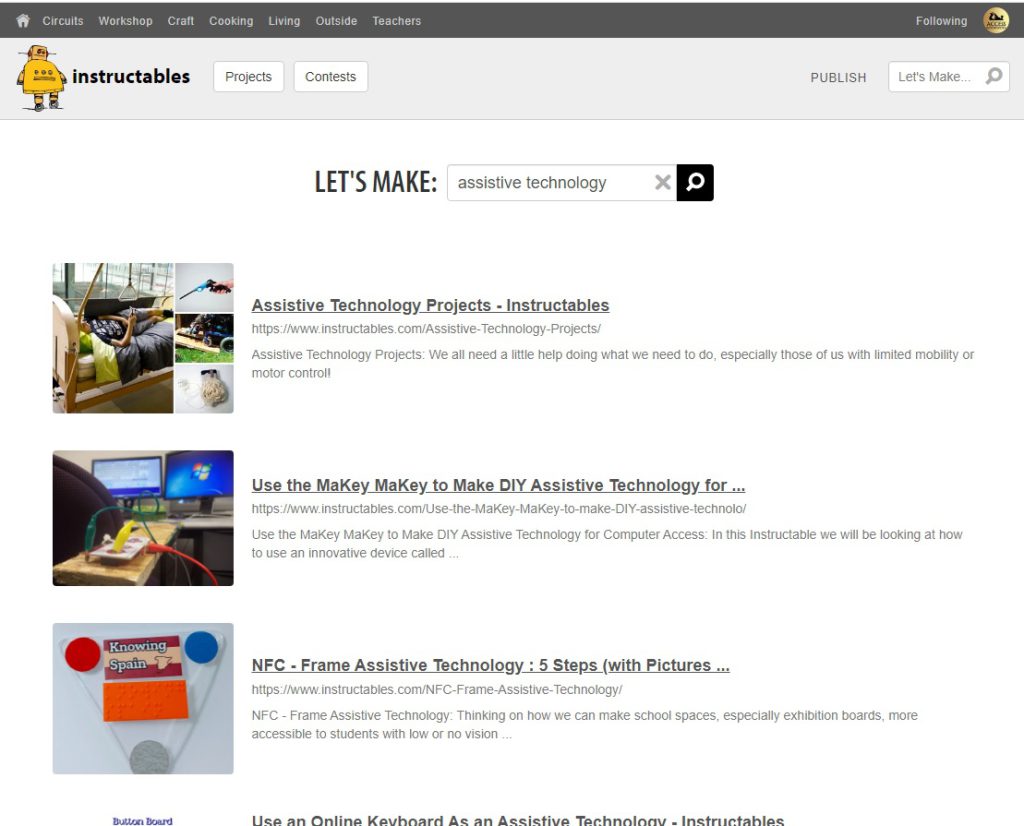Gifting Guide Day 20: Workshop DIY Gifts
Holiday Gifting Guide: DIY Assistive Technology Gifts
Nothing beats a holiday gift that someone has taken the time to make just for you! We have a whole lot of creative problem solvers and makers around our office and workshop, and many of us turn to the Instructables website for ideas on how to help people with disabilities.
Here is a sample of some projects that you could make (or ask Santa to make) as assistive technology.
Motorized Light Bulb Changer:
https://www.instructables.com/Motorized-Light-Bulb-Changer/

This project was developed by a gentleman who needed a way to change lightbulbs from a 2 story high chandelier, but someone in a wheelchair or of short stature could benefit from such a device. It contains a small motor, some other light electrical parts, some 3D printed parts, and a painter’s pole.
PVC Therapy Trike:
https://www.instructables.com/PVC-Therapy-Trike/

Instructions to build this child’s adapted tricycle were posted by volunteers for the Utah Assistive Technology Program. The adapted trike can be built for around $400 in materials, and is designed for children form ages 2 to 5 years, weighing under 50 pounds. Parts can be purchased from your local hardware store, or a kit can be purchased from www.uatpat.org .
Child’s Coloring Table:
https://www.instructables.com/Childs-Coloring-Table-Upcycled-From-Old-Side-Table/

I mentioned in a previous post how beneficial a table that holds rolled paper can be for children and adults with disabilities who which to draw, color, or paint. This project shows how one maker converted an old side table into an inexpensive coloring table.
WheeStroll- Wheelchair Stroller Attachment:
https://www.instructables.com/WheeStroll-Wheelchair-Stroller-Attachment/

This is a really neat project where a maker designed a system to attach an infant car seat to a wheelchair. The design combines off the shelf parts with some 3D printed brackets, and in beautiful in it’s simplicity.
Wheelchair Accessible Planter:
https://www.instructables.com/Wheelchair-Accessible-Planter/

These plans show how to build a planter that was used at a community garden for wheelchair accessibility. I like that it is deeper than most other designs I have seen, but still provide for knee space due to the way the bottom slopes. It is a nice design.
Doorbell Room Light:
https://www.instructables.com/Hearing-Impaired-Doorbell-Room-Light-Hack/

This project was developed by a young man whose parents could not hear the door bell ring. The standard wireless door bell flasher was not working, so he decided to make something that would flash the room lights. This is a great project for someone who wants to learn more about electronics, programming, and soldering.
Guitar Tuner for People who are Blind:
https://www.instructables.com/Guitar-Tuner-for-the-Blind-using-an-Arduino/

This is another great electronics project where a commercially available electronic guitar tuner has been modified with an Arduino microcontroller to change the visual output on the tuner to be played as tones through an earpiece.
Keep on Making!
I’ve always enjoyed making things in the workshop, and I have found common products can be easily tweaked to improve their form and fit for specific individuals. For example, I can make tool handles on chisels, screw drivers, and hammers thicker for some one with dexterity issues or arthritis. I can make wood turning gouges with longer handles for someone who might need to use a lathe while sitting in a wheelchair. Sometimes making your own assistive devices is the only way to meet a specific person’s need.
I could go on and on about all the cool projects on the Instructables website. It has something for every type of maker, whether you cook, sew, enjoy woodworking, gardening, electronics, programming, and especially for teachers. https://www.instructables.com/




